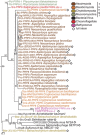Gene invasion in distant eukaryotic lineages: discovery of mutually exclusive genetic elements reveals marine biodiversity
- PMID: 23635865
- PMCID: PMC3749507
- DOI: 10.1038/ismej.2013.70
Gene invasion in distant eukaryotic lineages: discovery of mutually exclusive genetic elements reveals marine biodiversity
Abstract
Inteins are rare, translated genetic parasites mainly found in bacteria and archaea, while spliceosomal introns are distinctly eukaryotic features abundant in most nuclear genomes. Using targeted metagenomics, we discovered an intein in an Atlantic population of the photosynthetic eukaryote, Bathycoccus, harbored by the essential spliceosomal protein PRP8 (processing factor 8 protein). Although previously thought exclusive to fungi, we also identified PRP8 inteins in parasitic (Capsaspora) and predatory (Salpingoeca) protists. Most new PRP8 inteins were at novel insertion sites that, surprisingly, were not in the most conserved regions of the gene. Evolutionarily, Dikarya fungal inteins at PRP8 insertion site a appeared more related to the Bathycoccus intein at a unique insertion site, than to other fungal and opisthokont inteins. Strikingly, independent analyses of Pacific and Atlantic samples revealed an intron at the same codon as the Bathycoccus PRP8 intein. The two elements are mutually exclusive and neither was found in cultured Bathycoccus or other picoprasinophyte genomes. Thus, wild Bathycoccus contain one of few non-fungal eukaryotic inteins known and a rare polymorphic intron. Our data indicate at least two Bathycoccus ecotypes exist, associated respectively with oceanic or mesotrophic environments. We hypothesize that intein propagation is facilitated by marine viruses; and, while intron gain is still poorly understood, presence of a spliceosomal intron where a locus lacks an intein raises the possibility of new, intein-primed mechanisms for intron gain. The discovery of nucleus-encoded inteins and associated sequence polymorphisms in uncultivated marine eukaryotes highlights their diversity and reveals potential sexual boundaries between populations indistinguishable by common marker genes.
Figures





Similar articles
-
Massive intein content in Anaeramoeba reveals aspects of intein mobility in eukaryotes.Proc Natl Acad Sci U S A. 2023 Dec 5;120(49):e2306381120. doi: 10.1073/pnas.2306381120. Epub 2023 Nov 29. Proc Natl Acad Sci U S A. 2023. PMID: 38019867 Free PMC article.
-
Inteins and introns within the prp8 -gene of four Eupenicillium species.J Basic Microbiol. 2009 Feb;49(1):52-7. doi: 10.1002/jobm.200800168. J Basic Microbiol. 2009. PMID: 19253333
-
The distribution and evolutionary history of the PRP8 intein.BMC Evol Biol. 2006 May 31;6:42. doi: 10.1186/1471-2148-6-42. BMC Evol Biol. 2006. PMID: 16737526 Free PMC article.
-
The nuclear-encoded inteins of fungi.Fungal Genet Biol. 2007 Mar;44(3):153-79. doi: 10.1016/j.fgb.2006.07.012. Epub 2006 Oct 13. Fungal Genet Biol. 2007. PMID: 17046294 Review.
-
Enigmatic distribution, evolution, and function of inteins.J Biol Chem. 2014 May 23;289(21):14490-7. doi: 10.1074/jbc.R114.548255. Epub 2014 Apr 2. J Biol Chem. 2014. PMID: 24695741 Free PMC article. Review.
Cited by
-
Diversity of Viruses Infecting the Green Microalga Ostreococcus lucimarinus.J Virol. 2015 Jun;89(11):5812-21. doi: 10.1128/JVI.00246-15. Epub 2015 Mar 18. J Virol. 2015. PMID: 25787287 Free PMC article.
-
Effects of Cold-Surge-Induced Nearshore Seawater Icing on the Eukaryotic Microalgal Community in Aoshan Bay, Qingdao.Microorganisms. 2022 Dec 31;11(1):108. doi: 10.3390/microorganisms11010108. Microorganisms. 2022. PMID: 36677400 Free PMC article.
-
The dynamic intein landscape of eukaryotes.Mob DNA. 2018 Jan 24;9:4. doi: 10.1186/s13100-018-0111-x. eCollection 2018. Mob DNA. 2018. PMID: 29416568 Free PMC article.
-
Massive intein content in Anaeramoeba reveals aspects of intein mobility in eukaryotes.Proc Natl Acad Sci U S A. 2023 Dec 5;120(49):e2306381120. doi: 10.1073/pnas.2306381120. Epub 2023 Nov 29. Proc Natl Acad Sci U S A. 2023. PMID: 38019867 Free PMC article.
-
Abundance and Biogeography of Picoprasinophyte Ecotypes and Other Phytoplankton in the Eastern North Pacific Ocean.Appl Environ Microbiol. 2016 Jan 4;82(6):1693-1705. doi: 10.1128/AEM.02730-15. Appl Environ Microbiol. 2016. PMID: 26729718 Free PMC article.
References
-
- Bokor AA, Kohn LM, Poulter RT, van Kan JA. PRP8 inteins in species of the genus Botrytis and other ascomycetes. Fungal Genet Biol. 2012;49:250–261. - PubMed
-
- Burt A, Koufopanou V. Homing endonuclease genes: the rise and fall and rise again of a selfish element. Curr Opin Genet Dev. 2004;14:609–615. - PubMed
-
- Culley AI, Asuncion BF, Steward GF. Detection of inteins among diverse DNA polymerase genes of uncultivated members of the Phycodnaviridae. ISME J. 2009;3:409–418. - PubMed
Publication types
MeSH terms
Substances
LinkOut - more resources
Full Text Sources
Other Literature Sources
Molecular Biology Databases

